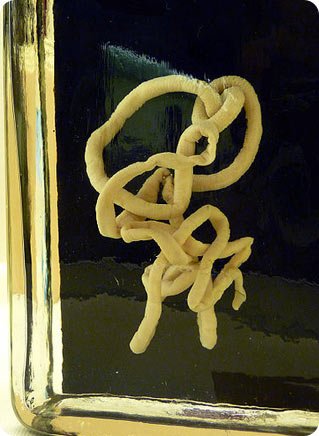
Now, here’s the thing: handling Bootlace worms isn’t just about being careful; it’s also about showing respect for their unique biology and habitat. After all, these worms play a significant role in marine ecosystems and should be treated with care. Think of it this way—just like you wouldn’t want someone mishandling your beloved pet, Bootlace worms deserve our attention and gentle treatment when we include them in educational settings.
Understanding Bootlace Worms
Bootlace worms, scientifically known as *Lineus longissimus*, are among the longest worms in the world, known for their impressive length and stunning coloration. Found primarily in coastal waters, these creatures can get quite lengthy—sometimes reaching up to 55 meters! If you’re thinking about including them in an educational display, it’s essential to know what makes them tick.
These worms are segmented and have a soft, flexible body. Their vibrant hues often include yellows, greens, and blues, making them visually striking. Even though they might look like a snake, they are quite different. They often move by contracting and expanding their body, almost like an artist painting a flowing line. But don’t let their beauty deceive you; Bootlace worms have a few tricks up their sleeves when it comes to defense. For instance, they can produce toxins if they feel threatened, which is something you definitely want to keep in mind while handling them.
Why Bootlace Worms Matter
Bootlace worms play a fundamental role in their ecosystems. They help break down organic matter on the ocean floor, making nutrients available for other marine life. This process is essential for maintaining healthy marine environments. When you educate others about Bootlace worms, you’re not just showing off a neat creature—you’re also highlighting the importance of biodiversity and ecological balance.
So, when you think about including Bootlace worms in your display, remember that you’re also raising awareness about their significance in the marine community. Connecting people with the natural world fosters a deeper appreciation for these fascinating creatures.
Preparing for Safe Handling
Before you even think about touching a Bootlace worm, there are some essential preparations to make. First, you’ll want to gather the right equipment. This includes a sturdy pair of gloves, a soft brush, and a secure container for transport. Trust me, having the right tools makes all the difference.
The gloves are crucial because, while Bootlace worms are not dangerous if handled properly, their slimy, slippery bodies can be a handful. The brush lets you clean off any debris from the worm without causing harm. And the container? Well, that’s where the magic happens—you need a safe space to transport the worm while ensuring it stays secure and stress-free.
Pay attention to the water quality in the container too. Bootlace worms thrive in clean, saltwater environments. Keeping the water at the right temperature and salinity is vital for their health, so make sure you have a way to monitor these conditions.
Creating a Comfortable Environment
Whether you’re preparing for a classroom demonstration or a public display, creating a comfortable environment for the Bootlace worm is key. Make sure the tank or display area mimics their natural habitat as closely as possible. This includes providing plenty of hiding spots, such as rocks or plants, where they can feel secure.
Lighting matters too. Too much bright light can stress them out, so consider using subdued lighting to create a calmer atmosphere. Remember, a relaxed Bootlace worm will give your audience a much better view of its beautiful movements and colors.
Safe Handling Techniques
Handling Bootlace worms requires a gentle touch and a bit of technique. When it comes time to pick them up, you’ll want to use both hands, cradling the worm carefully. Think of it like holding a delicate piece of art; you wouldn’t want to squeeze it too tightly or make it feel threatened.
Start by gently encouraging the worm to move towards your hands. It may take a bit of patience, as these creatures can be quite shy. If you notice any signs of stress—like rapid movements or trying to burrow away—take a step back. It’s essential to recognize when a Bootlace worm needs a little space.
While you’re handling the worm, keep it low to the ground. This minimizes the risk of a fall, which can hurt the creature. An extra set of hands is always helpful, especially during demonstrations and allowing everyone to get a good look without putting the animal at risk.
Educating the Audience
When showing Bootlace worms in educational settings, think about how you can engage your audience. Share fun facts, like how they can regenerate lost body segments or how they hunt for food. You might even consider having a live demonstration where students can observe them in action.
Interactive elements keep people interested, so if you can, allow your audience to ask questions during the presentation. This creates a fun, dynamic atmosphere, making the learning experience memorable. Plus, encouraging curiosity fosters a deeper appreciation for marine life, which is exactly what you want.
Dealing with Common Issues
Handling Bootlace worms isn’t all smooth sailing. You might run into a few common issues that require a little troubleshooting. For example, if the worm appears stressed, it’s vital to reduce any loud noises or sudden movements around it. Keeping the environment calm and quiet can help it relax.
Another issue might be the worm’s tendency to slip away quickly. Use your hands gently to corral it back toward safety if it begins to wriggle out of your grasp. Just remember, when they’re stressed, their movements can become erratic. Always prioritize their comfort and safety over a perfect demonstration.
Lastly, ensure your water conditions remain stable. Check the salinity, temperature, and cleanliness regularly, as any significant changes can impact the worm’s health. If you notice the water getting cloudy or dirty, do a quick change while keeping stress to a minimum.
Cleaning Up After the Display
After your educational presentation is complete, it’s time to take care of the Bootlace worm. Gently return it to its designated habitat, ensuring it’s in a comfortable environment. Check that the water quality is up to par and that the area is safe and secure for the worm.
It’s also vital to clean any equipment used during the handling. Rinse gloves, containers, and any tools thoroughly to prevent cross-contamination. Maintaining cleanliness not only keeps the worm healthy but also ensures your educational space remains in good order for future displays.
Emphasizing Respect for Nature
Ultimately, handling Bootlace worms for educational display is about more than just showcasing a fascinating creature. It’s an opportunity to emphasize the importance of respecting marine life and the ecosystems they inhabit. When we educate ourselves and others, we can foster a deeper appreciation for the natural world around us.
As you handle these extraordinary worms, remind your audience that they play a vital role in maintaining healthy ocean environments. By teaching proper handling techniques and the significance of these animals, we’re all contributing to greater awareness and conservation efforts.
So next time you think about incorporating Bootlace worms into a display, remember: it’s not just handling a worm; it’s about building a connection with nature and inspiring others to do the same.
In the end, showcasing Bootlace worms is about fostering curiosity and respect for our planet. By knowing how to handle them safely and effectively, you’re not just making a presentation; you’re making a positive impact on how people understand the beauty and importance of marine life.

